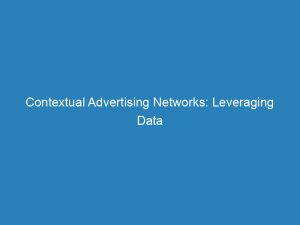- contextual advertising networks
- Introduction To Contextual Advertising Networks
- Machine Learning And Data Science In Contextual Advertising
- Projected Growth Of Contextual Advertising Market
- Utilizing Context For Targeted Ads
- Real-Time Content Analysis For Contextual Targeting
- Unique Landing Pages In Contextual Advertising
- Importance Of Contextual Advertising In The Era Of Privacy Laws
- Difference Between Contextual And Behavioral Advertising
In today’s digital era, where internet users are constantly bombarded with a plethora of advertisements, how can businesses ensure their ads truly resonate with their target audience? Enter contextualadvertising networks, a game-changer in the world of online advertising.
By leveraging dynamic algorithms and cutting-edge technology, contextual advertising networks analyze webpage content, location, and user behavior to deliver ads that seamlessly integrate with the user experience. With the projected growth of a staggering USD 376 billion by 2027, fueled by advancements in machine learning and the rising importance of privacy laws, contextualadvertising networks have become the go-to solution for marketers seeking effective and personalized ad targeting.
It’s time to dive deeper into this revolutionary advertising approach that is transforming the digital marketing landscape.
| Item | Details |
|---|---|
| Topic | Contextual Advertising Networks: Leveraging Data for Targeted Marketing |
| Category | Ads |
| Key takeaway | In today's digital era, where internet users are constantly bombarded with a plethora of advertisements, how can businesses ensure their ads truly resonate with their target audien |
| Last updated | December 27, 2025 |
contextual-advertising-networks">contextual advertising networks
Contextual advertising networks are platforms that utilize various factors, such as webpage content, location, and weather, to determine and deliver relevant ads to users. This type of advertising relies on machine learning and data science to target ads based on the context in which users are browsing.
With contextual advertising projected to reach USD 376 billion by 2027, it is becoming increasingly important in the digital advertising landscape. Unlike behavioral advertising, which focuses on user actions, contextual advertising targets the browsing context of users and analyzes content in real-time to determine their interests and potential actions.
Contextual advertising offers several benefits, including privacy-friendly data collection, easier implementation, and more relevant content delivery. It encompasses various categories like in-game, in-video, native, conversational, and AI advertising.
Notable examples of contextual advertising networks include Google AdSense, in-game ads in Sony’s Wipeout HD, and native ads that seamlessly blend with website content. The use of contextual advertising has proven successful for companies like CVS, which utilized it to reach consumers for flu-shot promotions, resulting in millions of visitors and ad impressions.
Furthermore, IBM Watson Advertising offers contextual advertising solutions that automate processes and optimize time, especially in the absence of third-party cookies. With the increasing focus on personalized recommendations and action predictions in conversational marketing and AI advertising, contextual advertising networks continue to play a significant role in delivering targeted and effective ads to users.Key Points:
- Contextual advertising networks use factors like webpage content, location, and weather to deliver relevant ads to users.
- It relies on machine learning and data science to target ads based on the context in which users are browsing.
- Contextual advertising is projected to reach USD 376 billion by 2027 and is becoming increasingly important in digital advertising.
- Unlike behavioral advertising, it focuses on the browsing context of users and analyzes content in real-time.
- Contextual advertising offers benefits like privacy-friendly data collection, easier implementation, and more relevant content delivery.
- Notable examples include Google AdSense, in-game ads in Sony’s Wipeout HD, and native ads that blend with website content.
Sources
https://www.forbes.com/sites/forbesagencycouncil/2021/07/22/the-new-rise-of-contextual-advertising/
https://www.ibm.com/watson-advertising/thought-leadership/what-is-contextual-advertising
https://www.g2.com/articles/contextual-advertising
https://www.publift.com/blog/contextual-advertising-everything-you-need-to-know
Check this out:
💡 Pro Tips:
1. Utilize AI-powered contextual advertising networks like IBM Watson Advertising to automate processes and optimize time, especially in the absence of third-party cookies.
2. Consider implementing conversational marketing and AI advertising to provide personalized recommendations and predict user actions, increasing the effectiveness of your ad campaigns.
3. Take advantage of the various categories of contextual advertising, such as in-game, in-video, native, and conversational advertising, to diversify your ad placements and reach your target audience in multiple contexts.
4. Explore creative ways to blend native ads with website content, like Google AdSense, to enhance user experience and make your ads more seamlessly integrated into the browsing experience.
5. If you’re promoting a specific event or promotion, leverage contextual advertising networks to target users in specific locations or based on local weather conditions, increasing the relevancy and effectiveness of your ads.
Introduction To Contextual Advertising Networks
Contextual advertising networks are paving the way for targeted marketing strategies by using advanced technology and data analysis to deliver relevant advertisements to users. This form of advertising takes into account various factors such as webpage content, location, and even weather conditions to determine which ads are most suitable for individual users.
By leveraging machine learning and data science, contextual advertising networks can effectively analyze user behavior and preferences to deliver personalized content.
Machine Learning And Data Science In Contextual Advertising
The success of contextual advertising networks relies heavily on the application of machine learning and data science. These technologies enable networks to gather and analyze vast amounts of data in real-time, allowing for precise ad targeting.
By constantly learning from user behavior, contextual advertising networks can better understand their interests and serve ads that align with their preferences. This ensures a higher level of engagement and conversion rates.
Projected Growth Of Contextual Advertising Market
The future of contextual advertising seems promising, as it is projected to reach a staggering USD 376 billion by 2027. This remarkable growth can be attributed to the increasing demand for personalized advertising and the effectiveness of contextual targeting.
As businesses continue to recognize the value of reaching the right audience with relevant content, the market for contextual advertising is set to expand substantially.
Utilizing Context For Targeted Ads
Context provides valuable information about user interests, making it a crucial component of targeted advertising. By understanding the context in which a user is browsing, such as the topic of a webpage or the current location, contextual advertising networks can deliver ads that are more likely to resonate with the user.
This approach ensures that users are presented with relevant content, increasing the chances of a positive response and conversion.
Fresh look at global CPC and CPM benchmarks.
Real-Time Content Analysis For Contextual Targeting
In order to deliver timely and relevant ads, contextual advertising networks utilize real-time content analysis. By analyzing the content of webpages as users access them, these networks can understand the context and make informed decisions about which ads to display.
This dynamic approach allows for effective ad targeting based on user actions and preferences, ultimately improving engagement and conversion rates.
Unique Landing Pages In Contextual Advertising
One key requirement for successful contextual advertising is the creation of unique landing pages for each ad. This ensures that the user is seamlessly directed to a page that is directly relevant to the ad they clicked on.
By providing a consistent and tailored experience, unique landing pages enhance user engagement and optimize conversion rates. This level of personalization demonstrates the commitment of businesses to deliver a seamless and user-centric experience.
Importance Of Contextual Advertising In The Era Of Privacy Laws
As privacy laws become more stringent and the phasing out of third-party cookies threatens traditional advertising practices, contextual advertising is becoming increasingly important. Unlike behavioral advertising, which relies on tracking user actions across the internet, contextual advertising targets the browsing context and does not rely on intrusive data collection.
This makes it a privacy-friendly alternative that respects user consent while still delivering relevant content.
Difference Between Contextual And Behavioral Advertising
It is important to distinguish between contextual and behavioral advertising as they serve different purposes. While contextual advertising focuses on analyzing the context in which users are browsing to deliver relevant ads, behavioral advertising places emphasis on tracking user actions and interests to tailor advertisements based on their past behavior.
While both approaches have their merits, contextual advertising offers privacy-friendly data collection, easier implementation, and a more accurate reflection of current user interests.
In conclusion, contextual advertising networks are revolutionizing targeted marketing by leveraging machine learning, data science, and real-time content analysis. With the projected growth of this market, businesses are recognizing the value of delivering personalized content to their audience.
Contextual advertising offers numerous benefits such as privacy-friendly data collection, easier implementation, and more relevant content delivery. As privacy laws and the limitations of third-party cookies come into play, contextual advertising is set to become a pivotal tool for businesses looking to optimize their marketing strategies.
Self-Serve DSP Platform • Native Ad Network • Buy Traffic • Performance Marketing Tips











